
Teak is a tropical hardwood tree species in the family Lamiaceae. It is a large, deciduous tree that occurs in mixed hardwood forests. Tectona grandis has small, fragrant white flowers arranged in dense clusters (panicles) at the end of the branches. These flowers contain both types of reproductive organs. The large, papery leaves of teak trees are often hairy on the lower surface. Teak wood has a leather-like smell when it is freshly milled and is particularly valued for its durability and water resistance. The wood is used for boat building, exterior construction, veneer, furniture, carving, turnings, and other small wood projects.

Tectona is a genus of tropical hardwood trees in the mint family, Lamiaceae. The three species are often collectively called teak.

The Philippine cobra also called Philippine spitting cobra or northern Philippine cobra, is a stocky, highly venomous species of spitting cobra native to the northern regions of the Philippines. The Philippine cobra is called ulupong in Tagalog, carasaen in Ilocano.

Nepenthes philippinensis is a tropical pitcher plant endemic to the Philippines. It is known from Palawan and the neighbouring Calamian Islands and Linapacan, where it grows at 0–600 metres (2,000 ft) above sea level.

Agathis dammara, commonly known as the Amboina pine or dammar pine, is a coniferous timber tree native to Sulawesi, the Maluku Islands and the Philippines.

The yellow-bellied whistler, or Philippine whistler, is a species of bird in the family Pachycephalidae that is endemic to the Philippines.
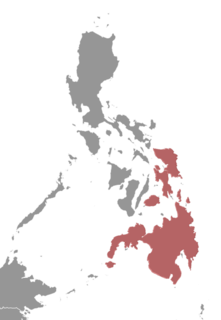
The Philippine tree squirrel is a species of rodent in the family Sciuridae which is endemic to the Philippines.

The lesser woolly horseshoe bat, also called Beddome's horseshoe bat, is a species of bat in the family Rhinolophidae. It is found in India and Sri Lanka. Its natural habitats are subtropical or tropical moist lowland forests, caves, and urban areas.

The large-eared horseshoe bat is a species of bat in the family Rhinolophidae. It is found in Australia, Indonesia, Malaysia, Papua New Guinea, and the Philippines.
Hopea philippinensis is a species of plant in the family Dipterocarpaceae. It is endemic to the Philippines. It is an endangered species threatened by habitat loss.
Persea philippinensis is a species of plant in the family Lauraceae. It is endemic to the Philippines. It is threatened by habitat loss.

The Philippine long-tailed macaque is a subspecies of the crab-eating macaque, known in various Philippine languages as matching/matsing or the more general term unggoy ("monkey"). It is endemic to the Philippine forests and woodlands, but especially in the mangrove forests of western central Philippines— particularly in Palawan, the Visayas, and Mindanao. The names M. f. philippinensis and M. f. philippinenesis have also been used, but arise from orthographical error.

Nepenthes palawanensis is a tropical pitcher plant endemic to Sultan Peak on the island of Palawan in the Philippines, where it grows at elevations of 1100–1236 m above sea level. It was discovered in February 2010 by Jehson Cervancia and Stewart McPherson.
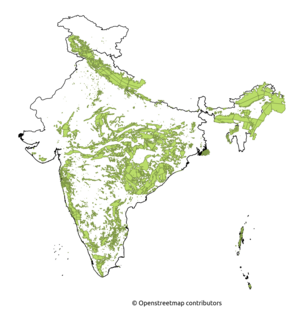
Tropical evergreen forests of India are found in the Andaman and Nicobar Islands, the Western Ghats, which fringe the Arabian Sea, the coastline of peninsular India, and the greater Assam region in the north-east. Small remnants of evergreen forest are found in Odisha state. Semi-evergreen forest is more extensive than the evergreen formation partly because evergreen forests tend to degrade to semi-evergreen with human interference. There are substantial differences between the three major evergreen forest regions.The average annual rainfall is 65-75 inches.
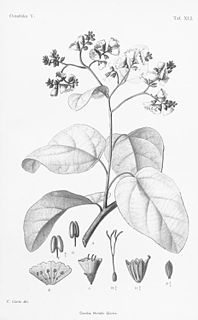
Cordia africana or Sudan teak is a mid-sized, white-flowered, evergreen tree in the borage family (Boraginaceae), native to Africa. It produces edible fruit, and its wood is used for drums or other carpentry.
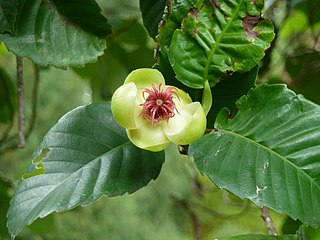
Dillenia philippinensis (katmon) is endemic to the Philippines and can be used for urban greening. Its fruit is known as elephant apple. Katmon grows in low to medium altitude forests throughout the Philippines, but does not survive the cold climates of the uplands.
Chiloconger philippinensis is an eel in the family Congridae. It was described by David G. Smith and Emma Stanislavovna Karmovskaya in 2003. It is a tropical, marine eel which is known from the Philippines, in the western central Pacific Ocean. It dwells at a depth range of 186–230 metres. Females can reach a total length of 19 centimetres.
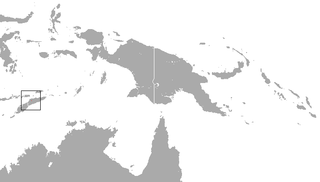
The Timorese horseshoe bat is a species of bat native to Timor-Leste.

Amesiella monticola is a miniature species of epiphytic orchid native to the Philippines. The specific epithet "monticola" refers to the montaneous habitat of the species. Monticola is a combination of "mons" or "montis", meaning mountain and "cola" or "colere" meaning "inhabitant" or "dweller".

















